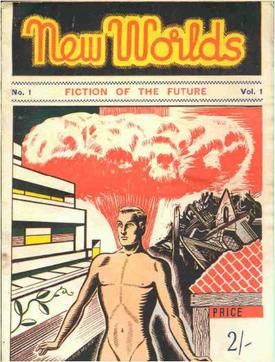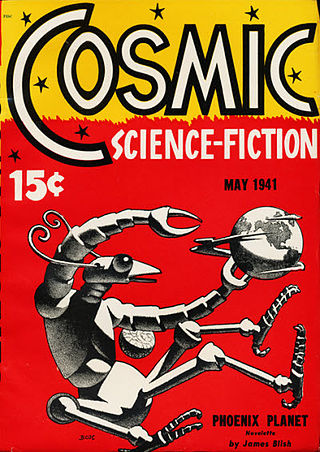
Blizzard of Ozz is the debut studio album by English heavy metal singer Ozzy Osbourne, released on 12 September 1980 in the UK and on 27 March 1981 in the US. The album was Osbourne's first release following his firing from Black Sabbath in 1979. Blizzard of Ozz is the first of two studio albums Osbourne recorded with guitarist Randy Rhoads prior to Rhoads' death in 1982. In 2017, it was ranked 9th on Rolling Stone's list of "100 Greatest Metal Albums of All Time".

Lawrence D. Lieber is an American comic book writer and artist best known as co-creator of the Marvel Comics superheroes Iron Man, Thor, and Ant-Man. He is also known for his long stint both writing and drawing the Marvel Western Rawhide Kid and for illustrating the newspaper comic strip The Amazing Spider-Man from 1986 to 2018. From 1974 to 1975, he was editor of Atlas/Seaboard Comics. Lieber is the younger brother of the late Marvel Comics writer, editor, and publisher Stan Lee.

New Worlds was a British science fiction magazine that began in 1936 as a fanzine called Novae Terrae. John Carnell, who became Novae Terrae's editor in 1939, renamed it New Worlds that year. He was instrumental in turning it into a professional publication in 1946 and was the first editor of the new incarnation. It became the leading UK science fiction magazine; the period to 1960 has been described by science fiction historian Mike Ashley as the magazine's "Golden Age".

Sherilyn Fenn is an American actress. She played Audrey Horne on the television series Twin Peaks for which she was nominated for a Golden Globe Award and an Emmy Award.
A Tom Swifty is a phrase in which a quoted sentence is linked by a pun to the manner in which it is attributed. Tom Swifties may be considered a type of wellerism. The standard syntax is for the quoted sentence to be first, followed by the description of the act of speaking, such as:
"If you want me, I shall be in the attic," said Tom, loftily.
Anthony D. Asher is an American songwriter and advertising copywriter who is best known for his collaborations with Brian Wilson and Roger Nichols in the 1960s. Asher co-wrote eight songs on the Beach Boys' 1966 album Pet Sounds, including the singles "God Only Knows", "Wouldn't It Be Nice", and "Caroline, No". According to Asher, he mainly served as a lyricist for Wilson's songs, but in some cases also contributed musical ideas. Asher also composed jingles, such as Mattel's slogan "You can tell it's Mattel—it's swell!", and contributed songs to The Partridge Family.

Yoshihiro Tatsumi was a Japanese manga artist whose work was first published in his teens, and continued through the rest of his life. He is widely credited with starting the gekiga style of alternative manga in Japan, having allegedly coined the term in 1957. His work frequently illustrated the darker elements of life.

Blemish is the sixth studio album by British singer-songwriter David Sylvian, released in May 2003 on Sylvian's Samadhisound label.

"'Til I Die" is a song by American rock band the Beach Boys from their 1971 album Surf's Up, subsequently issued as the B-side of the single "Long Promised Road". With autobiographical lyrics about death and hopelessness, it is one of the few songs in which both the words and music were written solely by Brian Wilson. An extended mix of the original recording, created by engineer Stephen Desper, was included on the 1998 Endless Harmony Soundtrack.

"Cabinessence" is a song by the American rock band the Beach Boys from their 1969 album 20/20 and their unfinished Smile project. Written by Brian Wilson and Van Dyke Parks, Wilson described the song as a "rock and roll waltz" about railroads, while Parks offered that the pair were attempting to write a song that would end on "a freeze frame of the Union Pacific Railroad". The instrumentation includes banjo, cello, dobro, bouzouki, fuzz-tone bass, trumpet, accordion, and percussion that was arranged to sound like the pounding of rail spikes.
Richard Mitchell was a professor, first of English and later of classics, at Glassboro State College in Glassboro, New Jersey. He gained fame in the late-1970s as the founder and publisher of The Underground Grammarian, a newsletter of opinion and criticism that ran until 1992, and wrote four books expounding his views on the relationships among language, education, and ethics.

The 1922 FA Cup final was contested by Huddersfield Town and Preston North End at Stamford Bridge. Huddersfield won by a single goal, a penalty scored by Billy Smith.

A Love Supreme is a Sunderland AFC fanzine, first published in 1989.
"Do You Like Worms?" is a song by American rock band the Beach Boys from their unfinished album Smile. Written by Brian Wilson and Van Dyke Parks, the song is about the recolonization of the American continent and contains references to the Sandwich Islands and "Bicycle Rider Back" playing cards. None of the lyrics appear to mention worms; asked about the title, Parks said he could not remember where it came from.
Jenny Cowern (1943–2005) was a visual, multi-media artist, who took inspiration from the natural surroundings of her adopted county, Cumbria, to produce some of the most dramatic and lasting images of nature. An acute observer of the continual change in the natural world, she took light and reflection, growth and decay, beaches and tides, pebbles and stones, clouds and shadows and manipulated them to capture a unique view of her surroundings. In addition to pen and ink, pencil, oils, watercolours, and pastels, a series of commissions enabled her to employ egg tempera murals, architectural designs, and industrial enamelling techniques. Irrespective of the media employed, it was with felt that she produced her most compelling and remarkable work. In the words of lifelong friend Duncan Smith: "Cowern took an ancient craft, pushed it in thrilling new directions and gave us contemporary pieces of the highest order."
James B. Simpson (1927-2002) was a journalist, author and Episcopal priest, best known for writing several volumes of Simpson’s Contemporary Quotations, a set of books of quotations. His work continues to be a trusted and recognized favorite among journalists, scholars, academics and quote enthusiasts.
Gary Penn is a former British games reviewer who wrote for Zzap!64 in the 1980s and is a video game industry veteran. He later was editor of The One from 1988 to 1990 and was Creative Director at DMA Design where he supervised the release of the first Grand Theft Auto game in 1997. Penn has described the game as taking years to develop and almost being cancelled.

Smile is an unfinished album by the American rock band the Beach Boys that was intended to follow their 1966 album Pet Sounds. It was to be an LP of twelve tracks assembled from modular fragments, the same editing process used for their "Good Vibrations" single. Instead, after a year of recording, the album was shelved and the group released a downscaled version, Smiley Smile, in September 1967. Over the next four decades, few of the original Smile tracks were officially released, and the project came to be regarded as the most legendary unreleased album in popular music history.

Cosmic Stories and Stirring Science Stories were two American pulp science fiction magazines that published a total of seven issues in 1941 and 1942. Both Cosmic and Stirring were edited by Donald A. Wollheim and launched by the same publisher, appearing in alternate months. Wollheim had no budget at all for fiction, so he solicited stories from his friends among the Futurians, a group of young science fiction fans including James Blish and C. M. Kornbluth. Isaac Asimov contributed a story, but later insisted on payment after hearing that F. Orlin Tremaine, the editor of the competing science fiction magazine Comet, was irate at the idea of a magazine that might "siphon readership from magazines that paid", and thought that authors who contributed should be blacklisted. Kornbluth was the most prolific contributor, under several pseudonyms; one of his stories, "Thirteen O'Clock", published under the pseudonym "Cecil Corwin", was very successful, and helped to make his reputation in the field. The magazines ceased publication in late 1941, but Wollheim was able to find a publisher for one further issue of Stirring Science Stories in March 1942 before war restrictions forced it to close again.

The Marilyn Monroe portfolio is a portfolio or series of ten 36×36 inch silkscreened prints on paper by the pop artist Andy Warhol, first made in 1967, all showing the same image of the 1950s film star Marilyn Monroe but all in different, mostly very bright, colors. They were made five years after her death in 1962. The original image was taken by Warhol from a promotional still by Gene Kornman for Monroe's film Niagara (1953).













